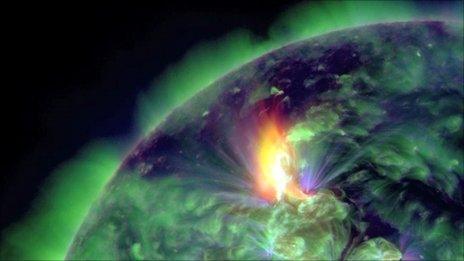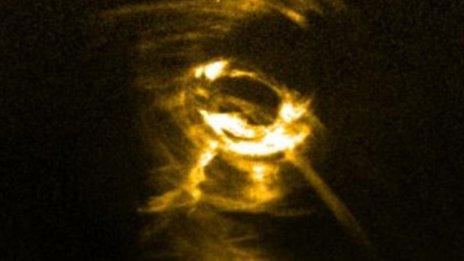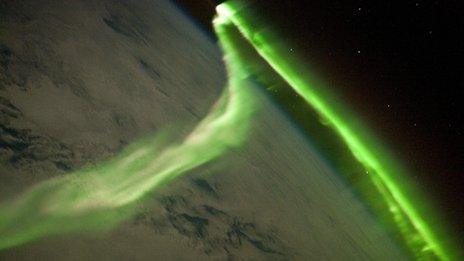A sombre warning from outer space
- Published

Artist's impression of a stellar flare hitting HD 189733b
If anyone ever needed a reminder of the awesome destructive potential of space weather, look no further than HD 189733b.
Slightly larger than Jupiter, HD 189733b is a huge gas giant orbiting very close to its parent star (HD 189733A), some 60 light years from Earth.
Although the planet has a blue sky, that's about where the similarities with earth come to an end. In fact it's so close to its parent star that a year lasts just 53 hours and temperatures hover at around 1000 degrees Celsius.
This proximity means that HD 189733b is constantly battered by space weather. Even so, researchers based at the Institute of Astronomy in Paris were astonished to witness the planet's atmosphere being blown away by a particularly violent burst of solar X-ray radiation.
The team, led by Alain Lecavalier des Etangs, used the Hubble Space Telescope to capture an image of the planet's atmosphere exiting stage left at a rate of a thousand tonnes a second.
"We haven't just confirmed the idea that some planets' atmospheres evaporate," Lecavalier claims, "we've watched the physical conditions in the evaporating atmosphere vary over time. Nobody has done that before."
The spectacle puts the Carrington Event of 1859 - the largest solar storm ever observed to hit the earth - into some sort of perspective.

Wide-field view of HD 189733b and surroundings
Aurorae were seen all around the world - so bright that gold miners in the Rockies assumed the sun was coming up and got up to make breakfast - as a huge solar flare triggered a coronal mass ejection that took just 17 hours to reach the earth.
Telegraph systems across Europe and North America failed, sparks flew from pylons, and some operators - unlucky enough to be working at the time - got a nasty shock.
As it happens British and American astronomers have been meeting to discuss our vulnerability to space weather at the Rutherford Appleton Laboratory this week.
After a prolonged period of relative calm the sun is cranking up again on its eleven-year cycle of activity.
That means a greater number of more powerful solar storms and flares with the potential to disrupt power supplies, transport and communications systems. And unlike 1859, when global electronic infrastructure was in its infancy, our dependence on high- tech computer systems and space-based satellite communications means the consequences could be much more profound than an admittedly spectacular atmospheric fireworks display and a few downed power lines.
Speaking at the conference the government's chief scientist Sir John Beddington welcomed the decision, taken earlier this year, to include severe space weather events on the National Risk Register.
"In the past it's fair to say we've been a bit blase about the threat posed by solar flares and storms" he said, "but the vulnerability of modern society is such that a space weather event would have enormous consequences for communications and satellite navigation systems and cause significant damage to the power grid network."
Even relatively small events can cause significant disruption.
Already this year Bob Routledge, from the US Space Weather Prediction Centre in Boulder Colorado, says long-haul flights crossing over the arctic have twice had to be re-routed to avoid potential disaster, while farmers in the mid-west were left unable to spray their crops after a solar flare caused a temporary shut-down of the GPS network controlling precision agriculture systems.
A temporary disruption to smart-farming systems, however, would be the least of our worries if we were ever exposed to the kind of atmosphere frying X-ray radiation currently bombarding HD 189733b. On reflection perhaps we should change that rather clumsy, technical name to Icarus.
- Published22 February 2012

- Published29 March 2012

- Published9 March 2012
